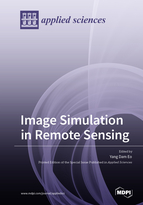Image Simulation in Remote Sensing
A special issue of Applied Sciences (ISSN 2076-3417). This special issue belongs to the section "Applied Physics General".
Deadline for manuscript submissions: closed (10 June 2021) | Viewed by 13452
Special Issue Editor
Special Issue Information
Dear Colleagues,
Large numbers of remotely-sensed images can be acquired from a diversity of multi-resolution sensors for distribution to a wide range of users. However, the atmospheric and environmental conditions present in the observed scene inevitably degrade the quality of remotely-sensed images. One method to overcome this limitation is by generating synthetic images through image simulation. Synthetic images can be generated by using statistical or knowledge-based models, or by using spectral and optic-based models to create a simulated image in place of the unobtained image at a specifically required time. Research on image simulation, or the generation of synthetic images, has rapidly been gaining interest. This Special Issue aims to attract novel contributions covering topics of interest which include, but are not limited to the following:
- Image simulation at specific time when obstructed by weather and atmospheric effects
- Image simulation using images from manufactured sensors
- Image simulation under virtual atmospheric and environmental conditions
- Optical image simulation from SAR images
- Optical image simulation from optical images
- Multi-resolution image simulation
- Image conversion for multi-sensor images obtained from different acquisition methods
- Image simulation by spectral resolution
Both theoretical and experiment-oriented papers, including case studies and reviews, are encouraged for submission.
Prof. Dr. YangDam Eo
Guest Editor
Manuscript Submission Information
Manuscripts should be submitted online at www.mdpi.com by registering and logging in to this website. Once you are registered, click here to go to the submission form. Manuscripts can be submitted until the deadline. All submissions that pass pre-check are peer-reviewed. Accepted papers will be published continuously in the journal (as soon as accepted) and will be listed together on the special issue website. Research articles, review articles as well as short communications are invited. For planned papers, a title and short abstract (about 100 words) can be sent to the Editorial Office for announcement on this website.
Submitted manuscripts should not have been published previously, nor be under consideration for publication elsewhere (except conference proceedings papers). All manuscripts are thoroughly refereed through a single-blind peer-review process. A guide for authors and other relevant information for submission of manuscripts is available on the Instructions for Authors page. Applied Sciences is an international peer-reviewed open access semimonthly journal published by MDPI.
Please visit the Instructions for Authors page before submitting a manuscript. The Article Processing Charge (APC) for publication in this open access journal is 2400 CHF (Swiss Francs). Submitted papers should be well formatted and use good English. Authors may use MDPI's English editing service prior to publication or during author revisions.
Keywords
- synthetic images
- simulated images
- multi-sensor
- image conversion






